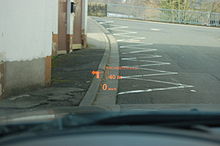An automotive head-up display or automotive heads-up display — also known as an auto-HUD — is any transparent display that presents data in the automobile without requiring users to look away from their usual viewpoints. The origin of the name stems from a pilot being able to view information with the head positioned "up" and looking forward, instead of angled down looking at lower instruments. At this time, there are three different approaches to OEM HUDs in automobiles. The first is to treat the back of the windshield in such a way that an image projected onto it will reflect to the driver. The second is to have a small combiner that is separate from the windshield. Combiners can be retracted. The third is to laminate a transparent display in between layers of the windshield glass.[1]





- ^ LUMINEQ. "How is LUMINEQ transparent display laminated in glass". www.lumineq.com. Retrieved 17 March 2022.